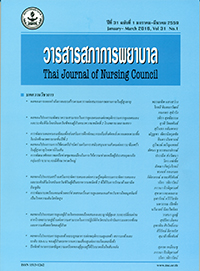ผลของโปรแกรมการดูแลผู้ป่วยโรคหลอดเลือดสมองและญาติผู้ดูแล ระยะเปลี่ยนผ่านจากโรงพยาบาลสู่บ้านต่อความสามารถในการปฏิบัติ กิจวัตรประจำวันภาวะแทรกซ้อน และความพึงพอใจของผู้ป่วย
Keywords:
โปรแกรมการดูแลระยะเปลี่ยนผ่าน, ผู้ป่วยโรคหลอดเลือดสมอง, ญาติผู้ดูแล, ความสามารถในการปฏิบัติกิจวัตรประจำวัน, ภาวะแทรกซ้อน, ความพึงพอใจ, transitional care programme, stroke patients, family caregivers, routine activity performance, satisfactionAbstract
บทคัดย่อ: วัตถุประสงค์:เพื่อศึกษาผลของโปรแกรมการดูแลผู้ป่วยโรคหลอดเลือดสมองและญาติ ผู้ดูแลระยะเปลี่ยนผ่านจากโรงพยาบาลสู่บ้านต่อความสามารถในการปฏิบัติกิจวัตรประจำวันภาวะ แทรกซ้อนและความพึงพอใจของผู้ป่วย
การออกแบบการวิจัยวิจัย:การวิจัยกึ่งทดลองแบบสองกลุ่ม วัดผลก่อนและหลังการทดลอง
วิธีดำเนินการวิจัย:กลุ่มตัวอย่างประกอบด้วยผู้ป่วยโรคหลอดเลือดสมองและญาติผู้ดูแล จำนวน 60 คู่ โดยแบ่งออกเป็นกลุ่มควบคุมจำนวน 30 คู่และกลุ่มทดลองจำนวน 30 คู่ กลุ่มตัวอย่าง กลุ่มควบคุมได้รับการดูแลตามปกติ ส่วนกลุ่มตัวอย่างกลุ่มทดลองได้รับการดูแลปกติร่วมกับการดูแล ด้วยโปรแกรมการดูแลผู้ป่วยโรคหลอดเลือดสมองและญาติผู้ดูแลระยะเปลี่ยนผ่านจากโรงพยาบาล สู่บ้าน เก็บรวมรวมข้อมูลจากการสัมภาษณ์ตามแบบสอบถาม ประกอบด้วย แบบสอบถามข้อมูลส่วนตัว แบบประเมินความสามารถในการปฏิบัติกิจวัตรประจำวัน แบบประเมินภาวะแทรกซ้อน และแบบ ประเมินความพึงพอใจในบริการที่ได้รับ วิเคราะห์ข้อมูลด้วยสถิติบรรยาย สถิติที และไคสแควร์
ผลการวิจัย: 1. หลังการจำหน่าย 1 เดือน กลุ่มตัวอย่างผู้ป่วยโรคหลอดเลือดสมองกลุ่มทดลองมี คะแนนความสามารถในการปฏิบัติกิจวัตรประจำวันสูงกว่ากลุ่มควบคุมอย่างมีนัยสำคัญทางสถิติ ( p<.001)
2. หลังการจำหน่าย 1 เดือน กลุ่มตัวอย่างผู้ป่วยโรคหลอดเลือดสมองทั้งสองกลุ่ม ไม่เกิดภาวะแทรกซ้อน
3. หลังการจำหน่าย 1 เดือน คะแนนความพึงพอใจของผู้ป่วยโรคหลอดเลือดสมอง กลุ่มทดลองสูงกว่ากลุ่มควบคุมอย่างมีนัยสำคัญทางสถิติ (p<.05)
ข้อเสนอแนะ: การนำโปรแกรมการดูแลฯ นี้ไปใช้ ควรปรับกิจกรรมในโปรแกรมให้เหมาะสม กับระดับความสามารถในการทำกิจวัตรประจำวันของผู้ป่วย
Abtract: Objective: To examine the efficacy of a transitional care programme designed
to engage family caregivers in helping stroke patients perform their routine activities,
and to evaluate the patients’ complications and satisfaction with the programme.
Design: Two-group experimental research with a pre-test and a post-test.
Implementation: This study was conducted on a sample of 60 pairs of participants,
each pair consisting of a stroke patient and his/her family caregiver. The pairs were equally
divided into a control group and an experimental group. Whilst the control group was given
standard treatment, the experimental group received, together with standard treatment,
the transitional care programme that engaged the participants’ family caregivers. Data were
collected through an interview questionnaire consisting of (1) a personal information
form; (2) a routine activity performance form; (3) a complication recording form; and
(4) a satisfaction rating form. The data were analysed using descriptive statistics, t-test
statistics and chi-square.
Results: From the study, three important findings were made. First, the participants
in experimental group achieved a significantly higher routine activity performance
score than those in the control group (p < .001). Second, one month after discharge,
no complications were found in the control group and the experimental group. Third,
one month after discharge, the participants in experimental group showed a significantly
higher degree of satisfaction than those in the control group (p < .05).
Recommendations: It is suggested that this programme be applied to examining
the routine activity performance ability of different groups of patients.
Downloads
References
American Stroke Association. Impact of Stroke ( Stroke
statistics). [ Internet ]. 2015. [ cited 2016 Fabuary 16 ].
Available from: http://www.strokeassociation.org/
STROKEORG/AboutStroke/Impact-of-Stroke-
Stroke-statistics_UCM_310728_Article.jsp#.
VsNY6_lYrcc.
Bureau of policy and strategy, office of the permanent
secretary, ministry of public health. statistical Thailand
[ Internet ]. 2013. [ cited 2016 Fabuary 16 ].
Available from: https://www.m-society.go.th/ewt_
news.php?nid=11378.
National Stroke Association. What stroke. [ Internet ].
[cited 2015 November 10]. Available from:
http://www.stroke.org/understand-stroke/what-stroke.
Phudhichareonrat S. Neuroanatomy and function of
of intracranial and extracranial vessels. In: Jukkutip P.
editor. [ Internet ]. 2011. [ cited 2016 Fabuary 16 ].
Available from: https:// www.phn. bangkok.go.th/
index.php?option=com_docman&task.
Peeravet K. Stroke rehabilitation. In: Charnnarong N.
editor. management of acute ischemic stroke. 3thed.
Bangkok: Faculty of Medicine, Chulalongkorn
University, Thailand; 2009. (in Thai)
Naylor M., Brroten D., Campbell R., Maislin G.,
Mccauley K.,Schwartz J. Transitional care of older
adults hospitalized with heart failure: A randomized,
controlled trial. JAGS 2004;52(5): 675-84.
Glass. Primary, Secondary, and Meta-Analysis of
Research. Educ Res 1976; 5(10): 3-8.
Pongsai N. Effect of transitional care on activities of
daily living among stroke patients (M.N.S thesis)
Chiang Mai: Chiang Mai University.; 2010. (in Thai).
Cohen, J. Statisticcal Power Analysis for the Bahavioral
Scienes. LE A.1998; (2): 281-406.
Yamvong C.Effects of application of Orem’s nursing
system on patients’ and relatives’ satisfaction with care
and functional outcomes in hospitalized elderly patients
(M.N.S thesis). Bangkok: MahidolUniv.;1995.
Isaacs,B., & Akhtar, J. The set test: A rapid test of
mental function in old peple: Age and aging 1972;
(1): 229-36.
Mahoney FI., and Barthel D. Functional evaluation:
The Barthel Index: Md State Med J 1965; 14: 56-61.
Disease Control and Prevention. HAI Difinitions.
[internet] 2013. [cited 2013 May 22]. Available
from: http://www.cdc.gov/.
National Pressure Ulcer Advisory Panel.NPUAP
Pressure Ulcer Stages/Categories [Internet] 2007.
[cited 2013 May 22]. Available from http://www.
npuap.org/.
Monro B.H., Jacobsen B.S., & Brooten D.A.
Re-examination of the psychometric characteristics
of the Lamonica-oberst patient satisfaction scale:
Res Nurs Health 1994; 17(2): 119-25.
Srithares W. The factors influencing caregiver role
strain of cerebrovascular disease patients’ wives
[Thesis]. Bangkok: Mahidol University.; 2003.
Matayomool C. Factors affecting to role strain of
caregivers in stroke patient [Thesis]. Bangkok: Mahidol
University.; 2003.
Noinawakul U, Pinyopasakul W, Kimpee S,
Puwarawuttipanit W. The effects of a walking exercise
program on perceived self-efficacy and functional
capacity in stroke patients with hemiparesis. Journal
of Nursing Science 2010; 28(4): 45-53. (in Thai).
Rachpukdee, S. Quality of life of stroke survivors:
a 3 month follow-up study [Thesis].Bangkok: Mahidol
Univ.; 2007.
Donprapeng, B. The relationship among caregiving
burden, cope resources and quality of live of dependent
older adults’ caregivers [Thesis]. Bangkok: Mahidol
University.; 2006.
Tubtimpradit J. Effect of caregiver preparation on
activities of daily living for stroke patients at Lampang
Hospital. (M.N.S thesis) Chiang Mai: Chiang Mai
University.; 2004. (in Thai).
P.Lannghorn, L. Robertson, J. Macdonald, L. Jones,
C. MacAlpine. F. Dick, et al. Medical Complications
After Stroke A Multicenter Study. [internt].2000.
[cited 2000 February 24]. Available from: http://
www.strokeaha.org/.
Eriksen.L.R. Patient satisfaction with nursing care:
concept clarification: J Nurs Manag 1995; 3(1): 59-76.
Sumarnjaroun A. Effect of home based management
intervention program for family caregivers of elderly
patient undergoing hip arthroplsty on elders’ postoperative
recovery andsatisfaction [Thesis]. Bangkok: Mahidol
University.; 2003.








